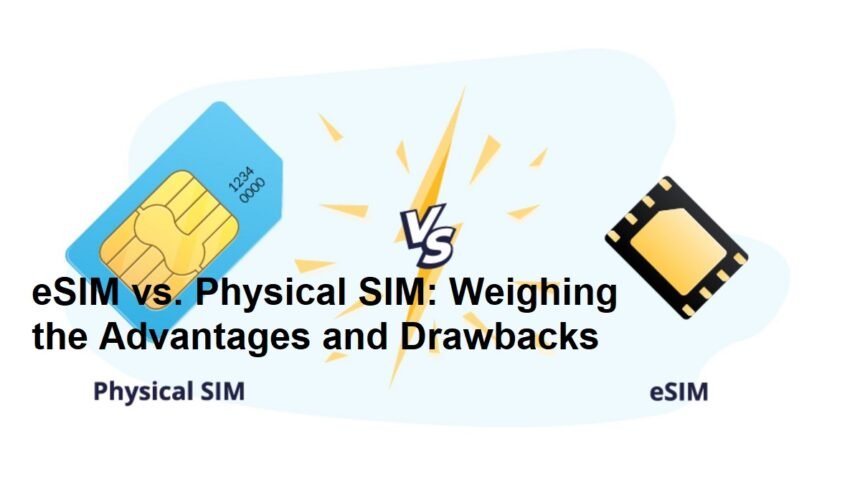The advent of embedded SIM (eSIM) technology is reshaping the way we connect to mobile networks. Unlike traditional physical SIM cards—which must be inserted, removed, and swapped to change carriers or plans—an eSIM is a tiny chip soldered directly onto a device’s motherboard. It can be programmed and reprogrammed over the air, allowing users to activate or switch service without ever handling a plastic card. As eSIM support expands across smartphones, tablets, wearables, and even laptops, it promises greater flexibility and streamlined device design. However, this innovation also brings new challenges. Here’s a closer look at the key advantages and disadvantages of eSIM compared to the familiar physical SIM.
Advantages
- Seamless Provisioning and Switching
With a physical SIM, changing carriers often means obtaining a new card, waiting for delivery, and performing a manual swap. eSIMs eliminate these steps: users simply scan a QR code or download carrier credentials via an app or settings menu. Within minutes, the new profile is activated. This is especially useful for frequent travelers, who can subscribe to local data plans on arrival without hunting down a shop or risking damage to their device by removing a tiny tray. - Multi‑Profile Capability
Many eSIM‑equipped devices can store multiple profiles simultaneously. You might maintain a personal and a business line on one phone, or keep both home and travel plans ready at all times. Switching between them is nearly instantaneous, with no need to physically juggle cards. - Sleeker, More Durable Design
Removing the SIM tray frees up internal space in ultra‑thin devices. Manufacturers can use that extra room for larger batteries, additional sensors, or reinforce water resistance. In rugged environments, a sealed eSIM contributes to a dust‑ and water‑tight chassis, reducing entry points for moisture and debris. - Environmental Benefits
Traditional SIM cards involve plastic production, packaging, and shipping—often wasted when discarded. eSIMs cut down on this physical waste. Over time, widespread adoption could reduce millions of plastic cards ending up in landfills each year.
Disadvantages
- Limited Carrier Support and Compatibility
While the number of eSIM‑capable carriers is growing, it still lags behind global physical SIM availability. Smaller or regional carriers may offer no eSIM option, forcing users to rely on plastic SIMs or forego certain networks altogether. Device compatibility varies too: not all eSIM‑enabled phones or tablets work on every carrier’s network, leading to potential frustration when switching providers. - Complexities in Device Transfer and Resale
With a physical SIM, handing your old phone to someone else is as simple as swapping cards. An eSIM is tied to the device’s hardware and managed through carrier portals, which means transferring a number to a new device can require more steps—and interactions with customer support. For second‑hand sales, resetting the eSIM profile may be nontrivial, potentially leaving buyers and sellers navigating confusing carrier procedures. - Dependence on Remote Provisioning Systems
eSIM relies on online carrier platforms to download and manage profiles. If a network’s eSIM server experiences downtime or a user lacks connectivity, they may be unable to activate service. In contrast, a physical SIM can be immediately recognized by any compatible unlocked device. - Security and Privacy Considerations
eSIM profiles are provisioned over the air, typically using encrypted channels. However, the remote activation process introduces a new attack surface: a malicious actor who gains control of an eSIM management system could theoretically push unauthorized profiles. Physical SIMs aren’t immune to SIM‑swap fraud, but the decentralized nature of plastic cards provides a slightly different risk profile—one that some users and carriers still prefer. - Potential Lock‑In and Policy Restrictions
Carriers control eSIM provisioning via credentials and contracts. Some may impose stricter terms or lock eSIM profiles to discourage switching. Policies vary widely: while one network might allow unlimited reprovisioning, another could limit the number of profile changes per year or require in‑store validation for each swap. This inconsistency can negate many of the convenience benefits touted by eSIM advocates.
Looking Ahead
eSIM technology represents a significant step toward a more flexible, streamlined mobile experience. For users who travel frequently, juggle multiple lines, or prioritize durable device design, its benefits are compelling. Yet the transition will take time: carriers must broaden support, standardize policies, and harden provisioning systems against emerging security threats. In the meantime, many will continue relying on the tried‑and‑true physical SIM. Ultimately, the balance between eSIM convenience and its current limitations will determine how quickly—and how universally—this next‑generation connectivity solution takes hold.












